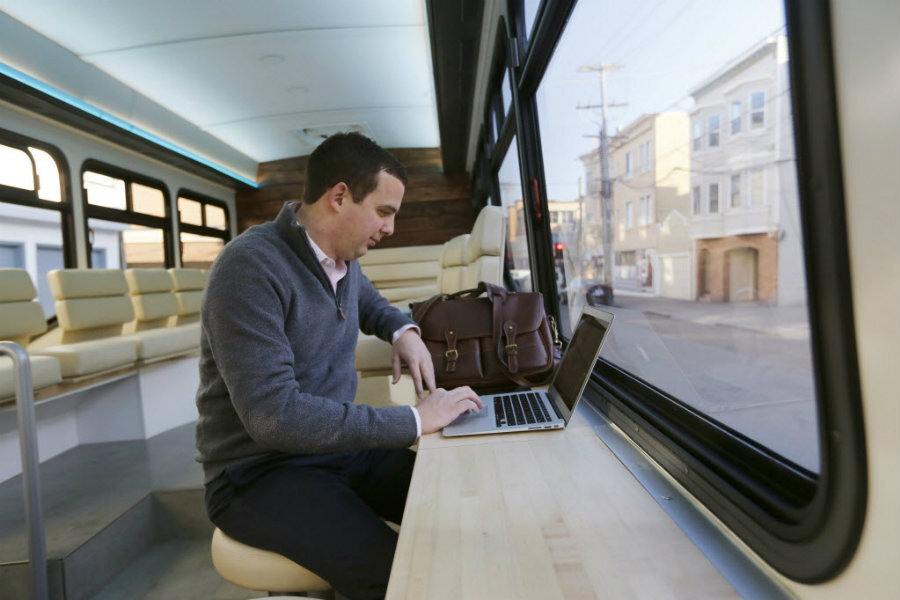Are San Francisco's luxury buses fueling inequality?
Loading...
Picture a morning commute that comes with leather seats, WiFi access, USB ports, and a selection of locally pressed juices.
Venture-backed luxury bus service Leap turned such wishful thinking into reality last week, when it began offering the comforts of its ritzy rides to San Francisco commuters willing to download a smartphone app and spend up to $6 a ticket.
The service – like ride-sharing apps Uber and Lyft before it – has sparked conversation about disruption in America’s traditional transit systems. Leap’s luxury shuttle may help address the issues of heavy commuter traffic and rising motor vehicle emissions, but the service’s relatively hefty price tag appears to further cement the low- and high-income divide already causing tension in cities such as San Francisco.
“So many people ride [the public bus system] who are low-income folks, things like this will never be available to them,” Tom Nolan, chairman of the San Francisco Municipal Transportation Agency, told The Examiner.
For the moment, he’s right.
Leap’s fare – which is about three times higher than the $2.25 cost of a ride on the Muni, San Francisco’s public transit system – can be paid via smartphone app, but not cash. The service is also currently limited to five buses with routes in the city’s wealthy Marina district, The Examiner noted.
Such a system, it could be argued, could serve to widen the class gap. This is especially true in San Francisco, where many already fear the tech industry is creating a system of high-cost amenities for its well-paid workers.
There’s also the worry that services like Leap would drain needed fares from public transit systems, turning the latter into “even more of a ride of last resort used primarily by the poor,” as The Washington Post’s Emily Badger put it.
Yet the reality is that public transit systems in almost every urban space in America are in dire need of a shakeup, Ms. Badger pointed out.
“If you were to look around any city and try to identify a problem in need of lucrative new solutions that emerging technology might provide, the dreaded commute is an obvious one,” she wrote in the Post’s Wonkblog.
The impacts of poor public transit are far-reaching: Not only does it slow economic mobility by limiting job access, it also negatively affects the environment.
One report, which examined bus rapid transit systems around the world, found that replacing traditional buses with more fuel-efficient models and having high-quality “busways” on roads and highways trimmed daily travel and waiting times by 15 minutes to an hour; expanded public transit reach; and could, over twenty years, reduce emissions by “an amount equivalent to the annual greenhouse gas emissions from more than 6.5 million passenger cars.”
Some cities, recognizing public transport’s vast impact, have already begun investing in them. The London Underground is in the midst of an $8 billion upgrade that will increase the speed of service and add nearly 200 new air-conditioned walk-through trains to four different lines to the city’s subway system, the BBC reported.
Danish company Midtraffik has also attempted to address the poor image of public transport in Denmark, releasing their “epic bus” ads to viral approval. (Some have questioned the apparent sexism in the videos, but that’s another story.)
Meanwhile, the US transit system remains fraught with issues, including delayed trains and buses, inadequate bus stops, and a commuting pecking order that has the lowest-income individuals dealing with what are perceived as the worst transit services.
“If you look at the demographics of commuter rail vs. the demographics of who rides the bus, you’ll find a higher concentration of people of color and lower income persons on the bus than you do on the trains,” Robert D. Bullard, dean at the School of Public Affairs at Texas Southern University and author of “Highway Robbery: Transportation Racism and New Routes to Equity,” told Pacific Standard magazine.
“All transit is not created equal,” Mr. Bullard added.
Could it not be said, then, that Leap and its $7 iced coffees are aggravating an already bad situation?
Maybe, the Post’s Badger wrote. But, she noted, the solution most certainly does not lie in forcing everyone to make do with slow, crowded, and broken transit systems.
“The answer isn't that higher-income riders should have to use poor public transit because lower-income riders do, too,” she wrote. “It's that we should throw innovation at the problem of public transit itself, not simply at the promise that some people could afford a work-around.”








